Chester
by Sue Wilkes
Chester's history is so exciting, and so much of it still visible, that it's difficult for the visitor to know where to begin. The city walls have had their ups and downs -- first a proud Roman fortress, then raided by Vikings, rebuilt by the Saxons and Normans, and bombarded during the Civil War. Chester is more peaceful nowadays; instead of warriors, its streets are busy with tourists and shoppers, armed to the teeth with credit cards and shopping bags.
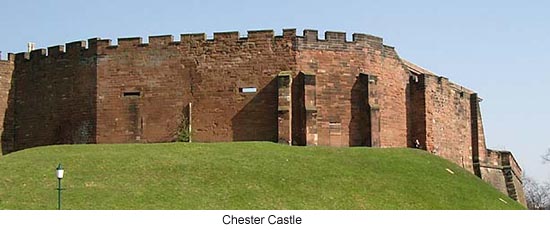
The keystones of the Roman occupation were the trio of fortresses at Caerleon, York and Chester. Roman Chester (DEVA or DEWA) began life as a military base around AD 50-60, then was consolidated into a large earth-and-timber legionary fortress, covering 60 acres, c. AD 76-79. One of Deva's main functions was to keep an eye on the rebellious Welsh -- a necessary task for the city long after the Romans departed.
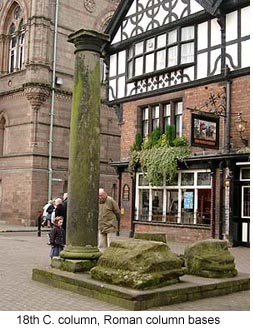 The history of Chester can only be sketched in through the troubled times of the Dark Ages. The kings of Mercia controlled the city during the 7th century; trade become important during Saxon times, and the town was rebuilt -- it even had its own mint. It was also a busy port. The history of Chester can only be sketched in through the troubled times of the Dark Ages. The kings of Mercia controlled the city during the 7th century; trade become important during Saxon times, and the town was rebuilt -- it even had its own mint. It was also a busy port.
One important, though debatable, date is the arrival of St. Werburgh's relics; this Mercian princess's remains were brought for safekeeping to protect them from invading Danes. Some authorities gave a date of c.875, others 907, when the Saxon burh (fortress) was founded by Athelflaeda, King Alfred's daughter. St. Werburgh's relics, which were said to have miraculous healing powers, were placed in a special shrine in a church, later to become Chester Cathedral.
The Norman Conquest of 1066 meant great changes for the people of Chester. At first, they refused to bow down to the Norman yoke, but William the Conqueror soon made his way north to change their minds. In 1070, the countryside of Cheshire was 'wasted' by William and his army; Chester fell to the Normans, and shortly afterwards boasted a motte-and-bailey castle, and a new owner: Earl Hugh Lupus, 'the Wolf.'
Chester's position by the Welsh border meant that, as in Roman times, it was a useful base from which to subdue the mutinous Welsh. The supplies and men needed to build the castles of Caernarvon, Conwy and many others, and to launch attacks on the rebels, were all routed via Chester. The defences of the city were strengthened; the castle was re-built in stone (the Agricola Tower, still standing, was a gate tower in the bailey wall) in the 12th century; the Roman walls were extended to their present-day dimensions. Around the 13th century, the medieval Rows, or shopping galleries, began to be established, but the buildings still followed much of the Roman street grid.
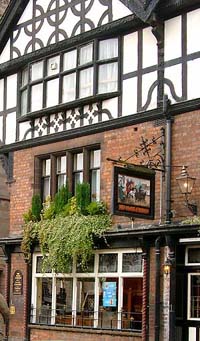 By the late 1200s the county was so important that it became a county palatine, i.e. it was self-governing. Commerce increased, but the Welsh were still causing problems; in 1402, a decree was passed banned Welsh people from the city between sunset and sunrise; in daylight they weren't allowed to hang about at inns, meet in groups larger than three people, or carry weapons other than a small knife to cut up their dinner. By the late 1200s the county was so important that it became a county palatine, i.e. it was self-governing. Commerce increased, but the Welsh were still causing problems; in 1402, a decree was passed banned Welsh people from the city between sunset and sunrise; in daylight they weren't allowed to hang about at inns, meet in groups larger than three people, or carry weapons other than a small knife to cut up their dinner.
Trades such as the leather industry were controlled by the guilds, which also produced the Chester Mystery Plays (religious pageants), performed during Whit week. (These are still staged every five years, but visitors have a long wait to enjoy them -- the next performance is not until 2008.)
Although still an important port, especially for passengers travelling to Ireland, the silting up of the River Dee by mid-15th century meant that trade began to decline, causing hardship to the citizens -- but worse was yet to come. Plague ravaged the city during the 1500s and 1600s; the Great Siege of Chester from 1644-46 badly battered the town's buildings and its inhabitants. Chester was loyal to King Charles I, and was strategically important because Charles Stuart needed access to his loyal troops in Ireland. Charles visited the city in 1642, and again in September1645, when he tried to relieve the siege. On the 24th, from the Phoenix Tower (now King Charles's Tower), he watched the remnants of his forces flee from their defeat by the Parliamentarians at Rowton Heath. Legend has it that he went to the Cathedral Tower in order to see the battle more clearly, but was nearly killed by a passing bullet -- how might history have changed if the bullet had hit its mark?
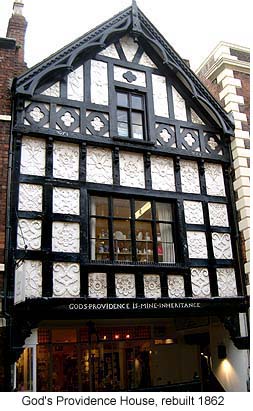 After the Restoration of Charles II, the prosperity of the town gradually recovered, especially after a channel was cut to make the Dee more navigable; the construction of canals and the new turnpike roads meant that by the mid-C.18th, Chester was a busy coaching town. Elegant classical buildings replaced many of the medieval Rows; the city walls, no longer really needed to defend the citizens, (despite the scare of the Jacobite rebellion of 1745) were transformed into a promenade or walkway; the medieval gateways Northgate, Bridgegate, Watergate and Eastgate were replaced by ornamental arches. "Thus this beautiful walk, the offspring of war, is now solely devoted to the purposes of pleasure, and salubrious enjoyment; and thus is evil sometimes the parent of good." (Cowdroy's Cheshire Directory, 1789.) After the Restoration of Charles II, the prosperity of the town gradually recovered, especially after a channel was cut to make the Dee more navigable; the construction of canals and the new turnpike roads meant that by the mid-C.18th, Chester was a busy coaching town. Elegant classical buildings replaced many of the medieval Rows; the city walls, no longer really needed to defend the citizens, (despite the scare of the Jacobite rebellion of 1745) were transformed into a promenade or walkway; the medieval gateways Northgate, Bridgegate, Watergate and Eastgate were replaced by ornamental arches. "Thus this beautiful walk, the offspring of war, is now solely devoted to the purposes of pleasure, and salubrious enjoyment; and thus is evil sometimes the parent of good." (Cowdroy's Cheshire Directory, 1789.)
In 1805, it took two days for the news of the great victory of Nelson at Trafalgar to reach the citizens of Chester, via the post-boys on the fast Royal Mail coaches. The progress of the war against Napoleon, and the antics of the Prince Regent in London and Brighton, were reported in rival newspapers the Chester Chronicle and the Courant, and talked over in the coffee-houses and inns of the city.
Regency Chester was a fashionable cathedral city, an important centre of local government. The County Palatine institutions were still in place; Chester had its own Exchequer and Court of Sessions. It had an active social calendar, with Chester Races, Hunt Balls, and plays at the Theatre Royal, where touring actors and actresses from London performed. The Theatre Royal was a converted chapel in Northgate-Street, Chester; theatre-goers saw famous personages as child prodigy Master Betty, the Young Roscius in 1804, actress Mrs. Jordan in 1813, and actor Edmund Kean in 1815.
Chester was still a significant port, although the 1801 census returns show that Liverpool had outstripped it in population size. Ships still sailed up the River Dee, and were built at the Crane boat-yards in Chester. Packet boats regularly left for Ireland from the seaside resort of Parkgate, famous for its sea air and bathing. The leather and glove-making industries gradually died away, but Chester became renowned for its makers of fine goods; clocks, silverware and cutlery. It bustled with activitiy; Cowdroy's Cheshire Directory (1789) lists mantua-makers, tallow-chandlers, dancing-masters and gunsmiths, to name just a few.
On a more solemn note, Chester was the execution centre for the whole county; the sheriffs were responsible for seeing condemned criminals 'turned off' at the gallows. Men and women were hanged for offences as major as highway robbery or murder, or as trivial as stealing a few yards of cloth. The 'lucky' ones might be reprieved and incarcerated in the notorious Northgate Gaol, or the House of Correction; publicly flogged, or transported to Australia.
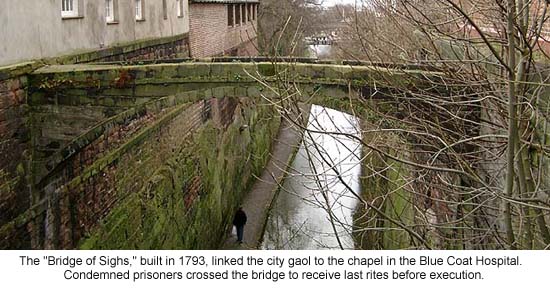
Until 1801, public executions took place at Gallows Hill, in Boughton. The last execution there was particularly gruesome. Three men were in the cart by the scaffold waiting to be hanged, when one John Clare escaped, and fell into the river Dee; the weight of his shackles sent him straight to the river bottom, and he drowned. But the letter of the law had to be carried out; the two other unfortunate men had to wait while Clare's body was fished out of the river, then they were all hanged together.
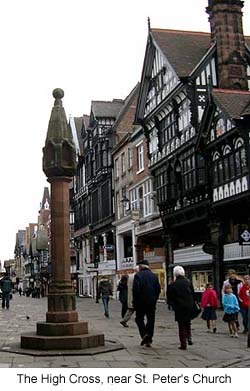 After 1801, condemned men were sent to Northgate Gaol for execution; later on, the city gaol. Thieves and coiners were not the only malefactors brought to justice - Luddites (machine-breakers) and the ringleaders of cotton-workers, rioting for better pay, were sent to the Castle Gaol. Savage game laws meant that poor men who poached to feed their families could be transported for seven years; but times were so hard that they braved mantraps and spring-guns anyway. After 1801, condemned men were sent to Northgate Gaol for execution; later on, the city gaol. Thieves and coiners were not the only malefactors brought to justice - Luddites (machine-breakers) and the ringleaders of cotton-workers, rioting for better pay, were sent to the Castle Gaol. Savage game laws meant that poor men who poached to feed their families could be transported for seven years; but times were so hard that they braved mantraps and spring-guns anyway.
Bull and bear baiting were commonplace, though the Police Act of 1803 was supposed to end the 'sport.' The annual bull-bait in Chester was eventually stopped, not just by concerns about animal welfare, but because of the civil disorder which accompanied the bloody spectacle. Cock-fighting also took place, although horse-racing at the Roodee became much more popular. The Roodee is Britain's oldest racecourse; it's a striking example of how far the sea has receded since Roman times, as it's the site of a tidal pool and Roman quay; part of the quayside is still visible beside the racecourse.
The Victorians enjoyed more enlightened pursuits. Chester became a prime tourist and shopping centre, its growth encouraged still further by the advent of the railways. Cheaper rail fares meant the poorer classes, too, began to travel more. The city was a popular stop for Americans on their way to London, after arriving at Liverpool. Writer George Borrow stayed in Chester in 1854 at the beginning of his Wild Wales tour.
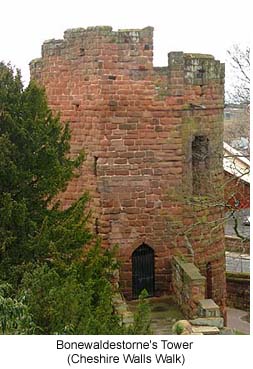 Chester's architecture saw huge changes in Victorian times. A new Town Hall was built. Many black-and-white half-timbered facades date from the 1850s, an attempt to revive the city's medieval architectural glory and save some of the creakier, older buildings in danger of demolition, such as God's Providence House in Watergate Street. The town's churches were restored by leading architects such as James Harrison and Sir George Gilbert Scott, whose work on Chester Cathedral, though controversial, undoubtedly preserved it for posterity. John Douglas, another fine architect, created many new buildings and transformed the city. Chester's architecture saw huge changes in Victorian times. A new Town Hall was built. Many black-and-white half-timbered facades date from the 1850s, an attempt to revive the city's medieval architectural glory and save some of the creakier, older buildings in danger of demolition, such as God's Providence House in Watergate Street. The town's churches were restored by leading architects such as James Harrison and Sir George Gilbert Scott, whose work on Chester Cathedral, though controversial, undoubtedly preserved it for posterity. John Douglas, another fine architect, created many new buildings and transformed the city.
The twentieth century brought different challenges, some decidedly for the worse. In the 1960s the town planners decided Chester's needs were best served by opening it up to traffic; the inner ring road was built. The city walls, which survived centuries of marauding invaders, the 'improvements' of the 18th century and bombing in WWII, were breached. Many significant, beautiful Georgian buildings were demolished, sacrifices to the internal combustion engine; the Victorian market hall was knocked down. Times have changed, however; conservation is now an on-going priority, and parts of the city have been pedestrianised, making shopping much more pleasant. The medieval Rows have been preserved; close your eyes, and imagine the busy scene in the 14th century, thronged with noisy street-hawkers, chattering townspeople and whinnying horses.
There are a number of guided walks available for visitors, including a Ghosthunter Trail, a History Hunter trail, and a Roman Soldier Walls Patrol (details from the Chester Tourism website.) Or you can explore the walls yourself; this is a great way to get a feel for the different stages of the city's history. Despite the ravages of time, the walls still form the most complete Roman and medieval circuit in Britain. On a sunny day, there are lovely views of the Clywdian hills, and there's always plenty of activity on the River Dee to watch. The walls walk is not suitable if you have mobility problems, however, because there are lots of steps.
The nice thing about walking along the walls is that you can leave them whenever you spot something particularly interesting, and rejoin them again later. These are just a few of the highlights you can see:
Roman remains
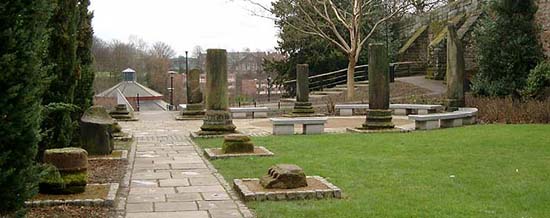
Several sections of the Roman defences remain; one of the best stretches is between the Northgate and King Charles's Tower. The Roman Gardens near Souter's Lane showcase some of the artefacts found while excavating sites in the town; there are Roman columns and a hypocaust from the Baths. The Amphitheatre, which could have seated more than 7000 Roman posteriors, is currently under excavation, and there are storyboards explaining what's been discovered so far. It was previously thought that the original amphitheatre was built with wood; recent excavations have shown, however, that both phases of the building were of stone; the later amphitheatre was more elaborate. Chester Visitor Centre is planning an Amphitheatre exhibition this summer, with archaeologists on site; archaeological guided tours are also available.
Chester Cathedral
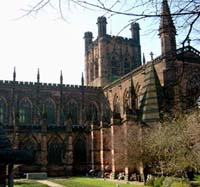 The church housing St. Werburgh's relics became a place of pilgrimage, and in 1092 Hugh Lupus re-founded it as St. Werburgh's Abbey, a Benedictine brotherhood. The monks had a brewhouse and bakery, cloisters and a refectory, and many other buildings. Around 1250, a new campaign of rebuilding took place, forming the basis of the structure visible today. The Abbey was rebuilt in the Gothic style, but this procedure took over two centuries to complete. The monks were known for their hospitality. The Dissolution of the Monasteries meant an end to the Abbey's days, but in 1541 Henry VIII relented, and the church was re-established as the Cathedral Church of Christ and the Blessed Virgin Mary. The pride of Chester, the Cathedral's appearance is predominantly Victorian. The striking Bell Tower, which you pass on the walls walk, was added in 1975. The Cathedral has over a million visitors a year; there is an admission charge, unless you are attending a service.
The church housing St. Werburgh's relics became a place of pilgrimage, and in 1092 Hugh Lupus re-founded it as St. Werburgh's Abbey, a Benedictine brotherhood. The monks had a brewhouse and bakery, cloisters and a refectory, and many other buildings. Around 1250, a new campaign of rebuilding took place, forming the basis of the structure visible today. The Abbey was rebuilt in the Gothic style, but this procedure took over two centuries to complete. The monks were known for their hospitality. The Dissolution of the Monasteries meant an end to the Abbey's days, but in 1541 Henry VIII relented, and the church was re-established as the Cathedral Church of Christ and the Blessed Virgin Mary. The pride of Chester, the Cathedral's appearance is predominantly Victorian. The striking Bell Tower, which you pass on the walls walk, was added in 1975. The Cathedral has over a million visitors a year; there is an admission charge, unless you are attending a service.
Eastgate
The most famous clock in Chester was erected to celebrate Queen Victoria's Diamond Jubilee n 1897 by Col. Evans-Lloyd; John Douglas designed the clock turret.
Chester Castle
The medieval castle, said to be on the site of a previous Anglo-Saxon fortress, has left few remains, apart from the Agricola Tower, part of the inner bailey, which contains a chapel to St Mary de Castro, dated some time between the 12th and 13th centuries. This room, which has some fine medieval wall frescoes, is now the Regimental Chapel.
The castle had a moat and drawbridge in the Middle Ages. Its main functions were an administrative centre, prison and garrison. Conditions in the jail were infamous, and did not improve until the 18th century, when the present-day beautiful buildings were added by Thomas Harrison, who rebuilt the castle during 1788-1822 in the Doric style. (Harrison also designed the much-needed second crossing over the Dee, the Grosvenor Bridge.) The Crown Court buildings by Harrison replaced the earlier Palatinate Courts.
Maps and guides are available from the Tourist Information Centre to help you make the most of your day out, and there are many cafes where you can take a break. Finally, don't miss Chester's very own Town Crier, in Regency dress, ringing his bell and making his proclamations at 12 noon on Tuesday to Saturday during the summer months.
Grosvenor Museum
The museum's foundation stone was laid on 3rd February 1885. It was built to house the Natural History Collections amassed by the Chester Society for Natural Science, Literature and Art. The Society's leading light was Charles Kingsley, Canon of Chester Cathedral. Chester architect Thomas Meakin Lockwood built the Renaissance-style building in red brick. The museum has a wonderful collection of Roman exhibits, including Roman tombstones. There's a natural history gallery, displays on the history of silver, and recreations of a Georgian drawing room and Victorian kitchen in the 'Town House.'
Cheshire Military Museum
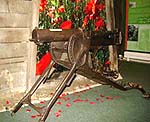 The museum building, by Harrison, originally provided accommodation for officers and soldiers. The Officers' Mess was in the building, previously the armoury, opposite to the museum. Major (later Field Marshal) Bernard 'Monty' Montgomery visited the Mess in the 1920s. The museum building, by Harrison, originally provided accommodation for officers and soldiers. The Officers' Mess was in the building, previously the armoury, opposite to the museum. Major (later Field Marshal) Bernard 'Monty' Montgomery visited the Mess in the 1920s.
Interactive and hands-on exhibits help tell the story of Cheshire's famous regiments, including the Cheshire Yeomanry and the Cheshire Regiment. The 'Cheshires' served in the Seven Years War and the American War of Independence. Two Victoria Crosses highlight the courage of the men who served in the World Wars.
Dewa Roman Experience
Experience the sounds, sights and smells of life inside the Roman fortress. Enter the Roman galley; try on a suit of Roman armour or fire a catapult. A reconstructed Roman street recreates life for ordinary people in Dewa. Hands-on activities for kids include taking part in a 'dig'; on-site museum.
Chester Zoo
The Zoo, which covers over 100 acres, was founded by George Mottershead in the 1930s. A leader in conservation and research, it is renowned for its ground-breaking animal enclosures. You'll need to set aside a whole day to make friends with the elephants, jaguars and giraffes in the beautiful Zoological Gardens. Take a ride on the Zoofari overhead railway or cruise on the Waterbus. In the wonderful Twilight Zone, opened by Douglas Adams in 1998, fruit bats swoop past you in their specially designed darkened 'forest.' Other special exhibits include Spirit of the Jaguar, Tsavo Black Rhino experience and Islands in Danger.
Related Articles:
- The Hidden Treasures of Chester Cathedral, by Julia Hickey
- https://www.timetravel-britain.com/articles/churches/cathedral.shtml
- Timeline: Chester, by Darcy Lewis
- https://www.timetravel-britain.com/articles/towns/chestime.shtml
- Hidden Churches of Cheshire, by Louise Simmons
- https://www.timetravel-britain.com/articles/churches/cheshire.shtml
- A Taste of Cheshire: Cheese, Pye and Pudding, by Dawn Copeman
- https://www.timetravel-britain.com/articles/taste/taste04.shtml
Related Reading:
Chester, by Peter Carrington (Batsford, 1994)
Chester, by Brian Harris (Bartholomew City Guide, Batsford 1979)
Chronicle of Chester, by Herbert Hughes, (Macdonald, 1975)
More Information:
We regret that we no longer have the resources to maintain up-to-date links and/or hours and pricing details for the various sites and attractions listed on this website. For more information about the location(s) listed above, please use your favorite search engine or visit Wikipedia.
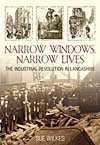 |
Sue Wilkes is a member of the Society of Authors. Her book Narrow Windows, Narrow Lives: The Industrial Revolution in Lancashire, an evocative look at everyday life during the Industrial Revolution in Lancashire, was published by Tempus (History Press) in 2008. Sue's next project is Regency Cheshire for Robert Hale. She lives in Cheshire with her family and two gerbils. To find out more visit http://suewilkes.blogspot.com/.
|
Article and photos copy; 2005 Sue Wilkes
Chester Castle and Eastgate Clock Photos © 2005 Nigel Wilkes
|
